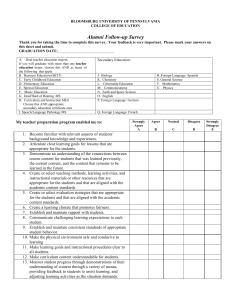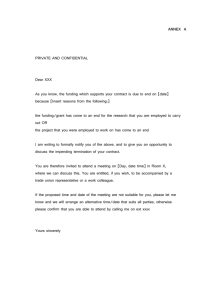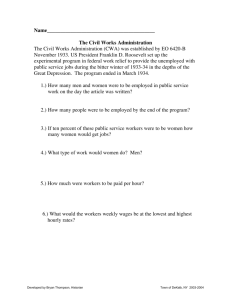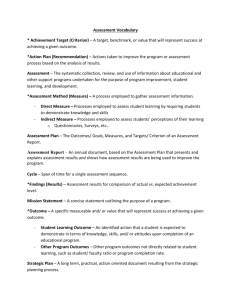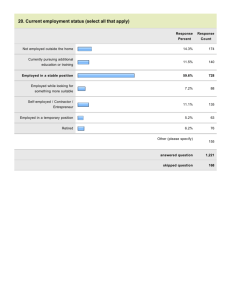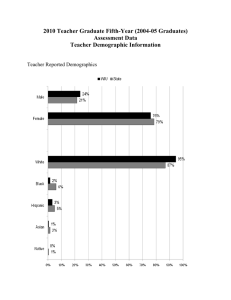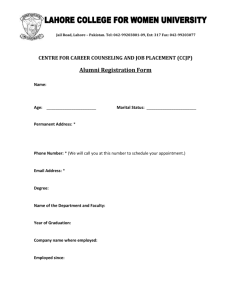1. My Report
advertisement
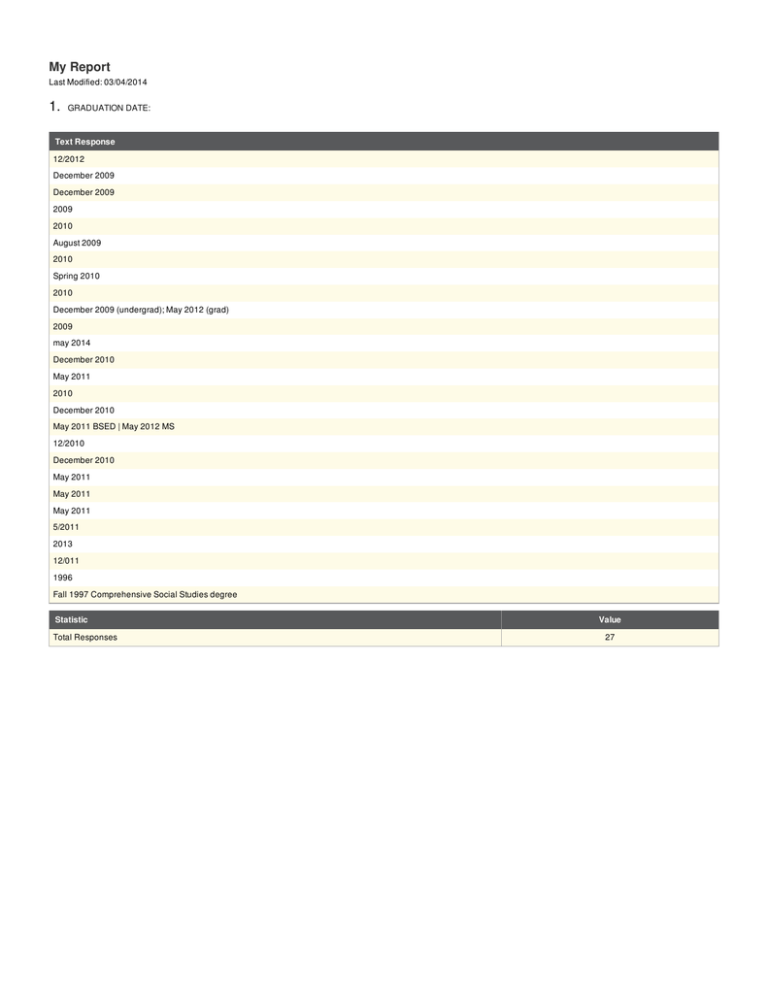
My Report Last Modified: 03/04/2014 1. GRADUATION DATE: Text Response 12/2012 December 2009 December 2009 2009 2010 August 2009 2010 Spring 2010 2010 December 2009 (undergrad); May 2012 (grad) 2009 may 2014 December 2010 May 2011 2010 December 2010 May 2011 BSED | May 2012 MS 12/2010 December 2010 May 2011 May 2011 May 2011 5/2011 2013 12/011 1996 Fall 1997 Comprehensive Social Studies degree Statistic Total Responses Value 27 2. Click to write the question text # Answer 1 Bar Response % A. Dual teacher education majors (If you will graduate with more than one teacher education major, choose this AND as many of the following that apply) 9 38% 2 B. Business Education (BCIT) 0 0% 3 C. Early Childhood Education 3 13% 4 D. Elementary Education 12 50% 5 E. Special Education 8 33% 6 F. Music Education 0 0% 7 G. Deaf/Hard of Hearing MS 0 0% 8 H. Curriculum and Instruction MEd (Choose this AND appropriate secondary education certificate area) 1 4% 9 I. Speech/Language Pathology MS 0 0% 10 J. (Secondary Ed.) Biology 0 0% 11 K. (Secondary Ed.) Chemistry 0 0% 12 L. (Secondary Ed.) Citizenship Education 3 13% 13 M. (Secondary Ed.) Communications 1 4% 14 N. (Secondary Ed.) Earth and Space Science 0 0% 15 O. (Secondary Ed.) English 0 0% 16 P. Foreign Language: German 0 0% 17 Q. Foreign Language: French 0 0% 18 R. Foreign Language: Spanish 0 0% 19 S. (Secondary Ed.) General Science 0 0% 20 T. (Secondary Ed.) Mathematics 3 13% 21 U. (Secondary Ed.) Physics. 0 0% Statistic Value Min Value 1 Max Value 20 Total Responses 24 3. My teacher preparation program enabled me to: # Question Strongly Agree Agree Neutral Disagree Strongly Disagree Total Responses Mean 1 1. Become familiar with relevant aspects of students’ background knowledge and experiences. 10 11 2 2 0 25 1.84 2 2. Articulate clear learning goals for lessons that are appropriate for the students. 13 10 2 0 0 25 1.56 3 3. Demonstrate an understanding of the connections between course content for students that was learned previously, the current content, and the content that remains to be learned in the future. 8 10 5 2 0 25 2.04 4 4. Create or select teaching methods, learning activities, and instructional materials or other resources that are appropriate for the students and that are aligned with the academic content standards. 10 12 2 1 0 25 1.76 5 5. Create or select evaluation strategies that are appropriate for the students and that are aligned with the academic content standards. 10 13 2 0 0 25 1.68 6 6. Create a learning climate that promotes fairness. 14 11 0 0 0 25 1.44 7 7. Establish and maintain rapport with students. 14 6 4 0 1 25 1.72 8 8. Communicate challenging learning expectations to each student. 11 8 6 0 0 25 1.80 9 9. Establish and maintain consistent standards of appropriate student behavior. 9 10 3 2 1 25 2.04 10 10. Make the physical environment safe and conducive to learning 11 10 3 0 1 25 1.80 11 11. Make learning goals and instructional procedures clear to all students. 10 12 3 0 0 25 1.72 12 12. Make curriculum content understandable for students. 10 12 2 1 0 25 1.76 13 13. Monitor student progress through demonstrations of their understanding of content through a variety of means, providing feedback to students to assist learning, and adjusting learning activities as the situation demands. 11 11 2 1 0 25 1.72 14 14. Use instructional time effectively. 9 15 1 0 0 25 1.68 15 15. Encourage students to extend their analytical and critical thinking. 8 10 4 3 0 25 2.08 16 16. Reflect on the extent to which the learning goals for students have been met. 9 12 3 1 0 25 1.84 17 17. Effectively teach students across relevant settings. 18 18. Build professional relationships with colleagues to share teaching insights, coordinate learning activities for students, and collaboratively solve problems. 19 9 11 4 1 0 25 1.88 12 5 5 3 0 25 1.96 19. Communicate with parents or guardians about student learning. 9 6 8 0 1 24 2.08 20 20. Differentiate instruction to address student diversity 9 12 2 2 0 25 1.88 21 21. Integrate technology into teaching and learning. 8 10 5 0 2 25 2.12 22 22. Demonstrate appropriate professional behaviors. 14 10 1 0 0 25 1.48 23 23. Have a positive impact on student learning. 14 10 1 0 0 25 1.48 24 24. Have a positive impact due to knowledge and skill of classroom management. 10 11 2 1 1 25 1.88 25 25. Have a positive impact due to knowledge and skill of discipline. 10 8 4 2 1 25 2.04 26 26. Have a positive impact due to knowledge and skill of planning 11 10 3 1 0 25 1.76 27 27. Have a positive impact due to knowledge and skill of implementing instruction. 9 13 1 1 0 24 1.75 28 28. Have a positive impact due to knowledge and skill of assessing instruction. 10 12 3 0 0 25 1.72 29 29. Have a positive impact due to knowledge and skill of reflecting on student learning. 8 14 2 1 0 25 1.84 30 30. Have a positive impact due to knowledge and skill of differentiating for student differences. 11 11 2 0 1 25 1.76 Statistic Min Value Max Value 1. Become familiar with relevant aspects of students’ background knowledge and experiences. 1 2. Articulate clear learning goals for lessons that are appropriate for the students. 1 3. Demonstrate an understanding of the connections between course content for students that was learned previously, the current content, and the content that remains to be learned in the future. 1 4. Create or select teaching methods, learning activities, and instructional materials or other resources that are appropriate for the students and that are aligned with the academic content standards. 1 5. Create or select evaluation strategies that are appropriate for the students and that are aligned with the academic content standards. 1 6. Create a learning climate that promotes fairness. 1 7. Establish and maintain rapport with students. 1 8. Communicate challenging learning expectations to each student. 1 9. Establish and maintain consistent standards of appropriate student behavior. 1 10. Make the physical environment safe and conducive to learning 1 11. Make learning goals and instructional procedures clear to all students. 1 12. Make curriculum content understandable for students. 1 13. Monitor student progress through demonstrations of their understanding of content through a variety of means, providing feedback to students to assist learning, and adjusting learning activities as the situation demands. 1 14. Use instructional time effectively. 1 15. Encourage students to extend their analytical and critical thinking. 1 16. Reflect on the extent to which the learning goals for students have been met. 1 17. Effectively teach students across relevant settings. 1 18. Build professional relationships with colleagues to share teaching insights, coordinate learning activities for students, and collaboratively solve problems. 1 19. Communicate with parents or guardians about student learning. 1 20. Differentiate instruction to address student diversity 1 21. Integrate technology into teaching and learning. 1 22. Demonstrate appropriate professional behaviors. 1 23. Have a positive impact on student learning. 1 24. Have a positive impact due to knowledge and skill of classroom management. 1 25. Have a positive impact due to knowledge and skill of discipline. 1 26. Have a positive impact due to knowledge and skill of planning 1 27. Have a positive impact due to knowledge and skill of implementing instruction. 1 28. Have a positive impact due to knowledge and skill of assessing instruction. 1 29. Have a positive impact due to knowledge and skill of reflecting on student learning. 1 30. Have a positive impact due to knowledge and skill of differentiating for student differences. 1 4 3 4 4 3 2 5 3 5 5 3 4 4 3 4 4 4 4 5 4 5 3 3 5 5 4 4 3 4 5 Mean 1.84 1.56 2.04 1.76 1.68 1.44 1.72 1.80 2.04 1.80 1.72 1.76 1.72 1.68 2.08 1.84 1.88 1.96 2.08 1.88 2.12 1.48 1.48 1.88 2.04 1.76 1.75 1.72 1.84 1.76 Variance 0.81 0.42 0.87 0.61 0.39 0.26 1.04 0.67 1.21 0.92 0.46 0.61 0.63 0.31 0.99 0.64 0.69 1.21 1.12 0.78 1.28 0.34 0.34 1.03 1.29 0.69 0.54 0.46 0.56 0.86 Standard Deviation 0.90 0.65 0.93 0.78 0.63 0.51 1.02 0.82 1.10 0.96 0.68 0.78 0.79 0.56 1.00 0.80 0.83 1.10 1.06 0.88 1.13 0.59 0.59 1.01 1.14 0.83 0.74 0.68 0.75 0.93 25 25 25 25 25 25 25 25 25 25 25 25 25 25 25 25 25 25 24 25 25 25 25 25 25 25 24 25 25 25 Total Responses 4. The following questions are worded in the same manner that Bloomsburg University must report to state and national agencies. You may have answered them with other surveys. We thank you, in advance, for your patience in answering them again below. # Question Yes No Total Responses Mean 1 1. Are you employed in an instructional, educational specialist, supervisory or administration position in Pennsylvania? 2 2. Are you employed in an instructional, educational specialist, supervisory or administration position outside Pennsylvania? 11 14 25 1.56 8 17 25 3 1.68 3. Are you employed in an education-related position in a location in Pennsylvania? 10 15 25 1.60 4 4. Are you employed in an education-related position in a location outside Pennsylvania? 10 15 25 1.60 5 5. Are you employed in a noneducation-related position in a location in Pennsylvania? 1 24 25 1.96 6 6. Are you employed in a noneducation-related position in a location outside Pennsylvania? 1 24 25 1.96 7 7. Are you NOT employed due to continuing your education? 1 24 25 1.96 8 8. Are you NOT employed due to your own choice, for example employment delayed for personal reasons? 0 25 25 2.00 Statistic 1. Are you employed in an instructional, educational specialist, supervisory or administration position in Pennsylvania? 2. Are you employed in an instructional, educational specialist, supervisory or administration position outside Pennsylvania? 3. Are you employed in an educationrelated position in a location in Pennsylvania? 4. Are you employed in an educationrelated position in a location outside Pennsylvania? 5. Are you employed in a noneducationrelated position in a location in Pennsylvania? 6. Are you employed in a noneducationrelated position in a location outside Pennsylvania? 7. Are you NOT employed due to continuing your education? 8. Are you NOT employed due to your own choice, for example employment delayed for personal reasons? Min Value 1 1 1 1 1 1 1 2 Max Value 2 2 2 2 2 2 2 2 Mean 1.56 1.68 1.60 1.60 1.96 1.96 1.96 2.00 Variance 0.26 0.23 0.25 0.25 0.04 0.04 0.04 0.00 Standard Deviation 0.51 0.48 0.50 0.50 0.20 0.20 0.20 0.00 25 25 25 25 25 25 25 25 Total Responses
